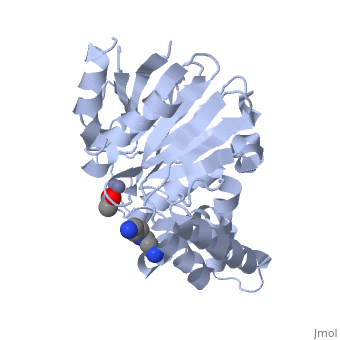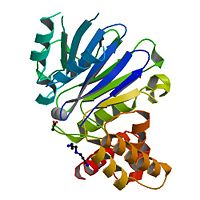Leishmania infantum Glyoxalase II
From Proteopedia
(Difference between revisions)
| Line 9: | Line 9: | ||
==Overview== | ==Overview== | ||
| - | The glyoxalase pathway catalyzes the formation of D-lactate from methylglyoxal, a toxic byproduct of glycolysis. In trypanosomatids, trypanothione replaces glutathione in this pathway, making it a potential drug target, since its selective inhibition might increase methylglyoxal concentration in the parasites. | + | The '''glyoxalase''' pathway catalyzes the formation of D-lactate from methylglyoxal, a toxic byproduct of glycolysis. In trypanosomatids, trypanothione replaces glutathione in this pathway, making it a potential drug target, since its selective inhibition might increase methylglyoxal concentration in the parasites. |
Evolutionary analysis shows that trypanosomatid ''L. infantum'' glyoxalase II diverged early from eukaryotic enzymes, being unrelated to prokaryotic proteins. This enzyme shows absolute specificity towards trypanothione, making it an exceptional model to understand the molecular basis of trypanothione binding and specificity. | Evolutionary analysis shows that trypanosomatid ''L. infantum'' glyoxalase II diverged early from eukaryotic enzymes, being unrelated to prokaryotic proteins. This enzyme shows absolute specificity towards trypanothione, making it an exceptional model to understand the molecular basis of trypanothione binding and specificity. | ||
Revision as of 08:39, 7 August 2012
| |||||||||||
Reference
Catalysis and structural properties of Leishmania infantum glyoxalase II: trypanothione specificity and phylogeny., Sousa Silva M, Barata L, Ferreira AE, Romao S, Tomas AM, Ponces Freire A, Cordeiro C, Biochemistry. 2008 Jan 8;47(1):195-204. Epub 2007 Dec 6. PMID:18052346
Created with the participation of Marta Sousa Silva, Eran Hodis, Lidia Barata.


